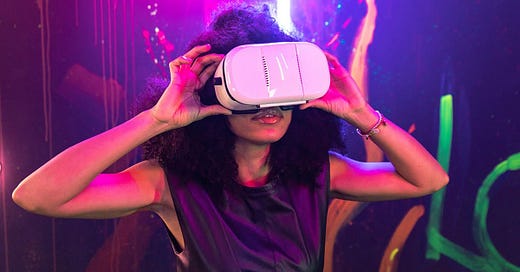Apple's mixed-reality headset sounds like an expensive beast
Expect to watch movies in space, in VR, this spring
It sounds like Apple is going all-in on its much-anticipated mixed-reality headset, which is rumored to have a pioneering hand-tracking system as well as a whole bunch of other features that will set it apart from the competitors like the upcoming Meta Quest 3.
Courtesy of Bloomberg, we’ve now got a better idea of what to expect from the long-rumored device. As previously suggested, it will reportedly be called Reality Pro and be aimed at both commercial and consumer uses. It’s the first new product category Apple will launch since the Apple Watch in 2015 and is estimated to sell at a whopping $3,000 – that’s miles above the price of the Meta Quest 2, even after last year’s price hike, double that of the Meta Quest Pro, and almost triple the price tag of HTC’s recent premium mixed-reality headset.
➡️ The Shortcut Skinny: Apple’s VR-AR headset
🤤 Apple’s long-rumored mixed-reality headset sounds very impressive
🌟 Called the Reality Pro, the device will support tons of trailblazing features
👀 The biggest among them is its controller-free operation based on eye-tracking
💃 And its ability to realistically render users’ whole bodies in a virtual space
Apple’s 1,000-person development team has reportedly spent seven years tinkering with the device and hopes it will make a big splash with premium features that aren’t offered elsewhere.
Using internal headset sensors, it will be able to track the movement of the user’s eye and read where on the screen they’re looking. Users will then be able to squeeze their thumb and forefinger together – detected by the device’s external cameras – to make a selection on-screen. It’s a huge change from other headsets that require users to navigate apps and make selections using external, handheld controllers.
On top of that, the headset is being pitched with specific business uses in mind, like a VR version of FaceTime that supports video conferencing. If two users wearing Reality Pro headsets jump into a FaceTime call, the devices will realistically render their full bodies as avatars in a virtual meeting room, letting them interact as if they were face to face.
While Apple is expected to roll out its own version of the metaverse – that is, virtual social meet-up spaces – realistic-looking avatars will only be available in one-on-one FaceTime chats because of the immense processing power required to generate them.
As a mixed-reality headset, it will support a pass-through mode, which lets users use toolsets on top of the real environment around them, and supports prescription lenses for those who usually wear glasses.
Apple is also developing an “immersive video watching” feature for the device that can “make viewers feel like they’re seeing a movie on a giant screen in another environment, such as a desert or outer space”. Although you’ll need to wear a pair of AirPods Pro earbuds to hear movies in spatial audio. It will also transpose many of the iPhone’s and iPad’s features to a 3D environment, including their photos, mail, messages and calendar apps, the Safari web browser, and a new App store for third-party releases.
It’s also expected to offer games from third-party developers, and we’ve already seen Apple pinch a couple of game developers to work on its mixed reality tech. Don’t expect it to support nearly as many games as all the upcoming PSVR 2 games, though – it may support gaming, but hasn’t been designed, nor will likely be marketed, as a gaming-first platform.
In another contrast to Meta’s VR tech, the Reality Pro won’t have a battery built into the headset. Instead, it will run off an external battery pack, which apparently lasts for around two hours and is the size of two iPhone 14 Pro Maxes stacked on one another.
As previously expected, Apple is likely to publicly unveil the device later this spring ahead of WWDC. Bloomberg reports that Apple is considering exclusively selling the device in the US at launch, and is already working on a budget alternative that will sell closer to $1,500 sometime in late 2024 or early 2025.




